
(R Lambert)
Austin Miller’s Cooper T51 Chev during his Australian Land Speed Record setting day-163.94mph at Bakers Beach, Tasmania watched by ‘four men and a dog’ on Monday 20 November 1961…
Only in Australia would a significant event like this have been achieved in such a clever, low key kind of way, still, the fellows involved were doers and goers not spruikers and bullshitters.
Watching him blast through the timing gear at over 160mph are car-builder Geoff Smedley, Bruce Burr, a few members of the local press and a small number of onlookers who have made their way to the quiet stretch of beach on Tasmania’s far north coast, 80 km from Launceston, the ‘Northern Capital’ of the island state.
When I first saw Ron Lambert’s image it simply blew my mind on a whole lot of levels other than its purely visual impact, powerful as it is. It says so many good things about this country and the understated, pragmatic, often ingenious way we tend to go about things.
Miller was born in Melbourne in 1923, in common with most of his contemporaries from around the world he enlisted to fight in WW2. He joined the army and became a tank instructor but he was keen to fly so moved from the Australian Army to the Royal Australian Air Force where he learned to fly in Tiger Moths before graduating progressively through the Wirraway trainer and on to Mustang and Spitfire fighters.
Post war, keen to stay in aviation- and there were plenty of great pilots in the world at that point in time, Aussie and his friend Ernie Tadgell formed Super Spread Aviation Pty. Ltd. a commercial crop dusting enterprise they commenced in 1952- Austin was Victoria’s first ‘Ag-pilot’.
Miller commenced racing a TQ Midget on Victorian and New South Wales’ speedways, then switched to circuit racing, first coming to prominence in 1958 when he won his class of the Victorian Road Racing Championship and the Victorian Trophy in the ‘Miller Special’, a Cooper T41 Climax FWB acquired in the UK. His good mate, Stan Jones won the Gold Star that year in a magnificent Maserati 250F with Austin taking second and third places in the Port Wakefield and Phillip Island rounds.
Austin identified the Cooper for sale in England albeit the Australian connection was that fellow Victorian Paul England had been racing the ex-Ken Wharton ‘F2/2/56’ or ‘F2/4/56’ machine throughout Europe in 1957 and was now ready to come home. I wrote about the car a while back, click here to read about it; https://primotipo.com/2015/05/20/aussie-miller-cooper-t41-climax-trevallyn-hillclimb-launceston-tasmania-1959/
One of the apocryphal Miller stories concerns the delivery of two Percival EP.9 aircraft (see the link at the end of the article about these interesting planes built in the UK by Australian born designer Edgar Percival) from Stableford Aerodrome in Essex where they were designed and built, back to Australia in 1957.
The duo were looking for replacements for their ageing fleet of Tiger Moths and first visited the US in 1956 where they test flew Stearman, Fletcher and Cessna aircraft before going to the UK in 1957 where the choices were the Auster Agricola or Percival EP.9 with the latter finally getting the nod.
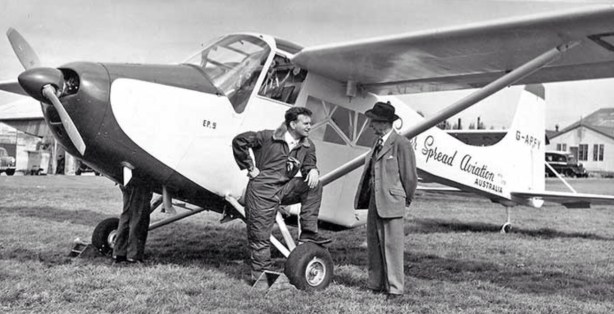
Austin ‘on arrival at home base Moorabbin after he and partner Ern Tadgell flew G-APFY and G-APBR in company from England on delivery’ Percival EP.9 (Goodall)
Aussie and Ern left England on 19 September 1957, included amongst the bits and pieces in the planes’ holds as ‘aircraft spare parts’ were the Cooper T41 and a Lotus 12 Climax which had been disassembled into their constituent parts and boxed as spares, crop spraying equipment etc.
This type of ruse, that is bringing racing cars into the country in parts was a well travelled path for Australian racers for decades to avoid the net of the ‘fiscal fiend’ whose import duties were punitive in nature and rapacious in quantum. The cars were called the ‘Miller Special’ and ‘Sabakat’ respectively when they arrived in the Great Brown Land with the chassis plates kept well away from the two machines and prying eyes.
The intrepid Percival pilots made thirty-two stops between the Old Dart and Oz before arriving at home base, Moorabbin Airport in Melbourne’s south on 27 October 1957- what an adventure! In fact it was very much so as Austin’s plane barely made it in to Darwin from Kupang as a result of heat from the exhaust causing the thermostatically controlled carburettor to lift the needle, burning excessive amounts of fuel, the tank was so dry, its said, that he couldn’t taxi the Percival to the hangar in Darwin.
Needless to say the ‘aircraft parts and crop spraying equipment’ were soon assembled into a couple of handy looking racing cars by the pair of aviation scallywags. Tadgell’s first Australian appearance in Sabakat was at the South Pacific Trophy meeting at Gnoo Blas, Orange over the Australia Day long weekend in January 1958 whereas Austin’s first run aboard the Miller Special/Cooper T41 was at Longford in 1959. Checkout this epic on the Lotus 12 here, inclusive of Sabakat; https://primotipo.com/2019/08/22/just-add-lightness/

Austin, Cooper T41 Climax, Trevallyn Hillclimb, Launceston 1959 (unattributed)
Miller first raced the Cooper at Phillip Island in January 1958 and over the next few years ran it in everything going- races, sprints and hillclimbs, self preparing the machine amongst the aircraft in his Moorabbin hanger, but he didn’t race much that year due to an extremely nasty Percival accident at home base on 15 April.
Super Spread by that time had three EP.9’s, the final aircraft was assembled in Australia from components acquired in the UK. The EP.9 ‘VH-SSW’ had just been rebuilt following a crash at Flinders Island in February, with the work complete Austin took off at dusk together with engineer Bill Symons- immediately after takeoff he climbed steeply, the aircraft stalled and crashed close to the Moorabbin Control Tower. The Department of Civil Aviation investigation found the cause of the accident to be elevator cables which had been installed wrongly so as to reverse normal operating sense. Both Miller and Symons were badly hurt, the severely damaged airframe was struck off the register and scrapped.
After recovery and with the responsibilities of a young family- Austin met Judy, later to become his wife, a nurse at the Alfred Hospital in Melbourne recovering from another nasty accident at Thorpdale, Victoria, Miller moved to Launceston to take over as the licensee of the Hotel Monaco. Aussie had been a Longford regular during the late 1950’s so the move across Bass Straight from Victoria to Tasmania was an easy one to a place he loved.
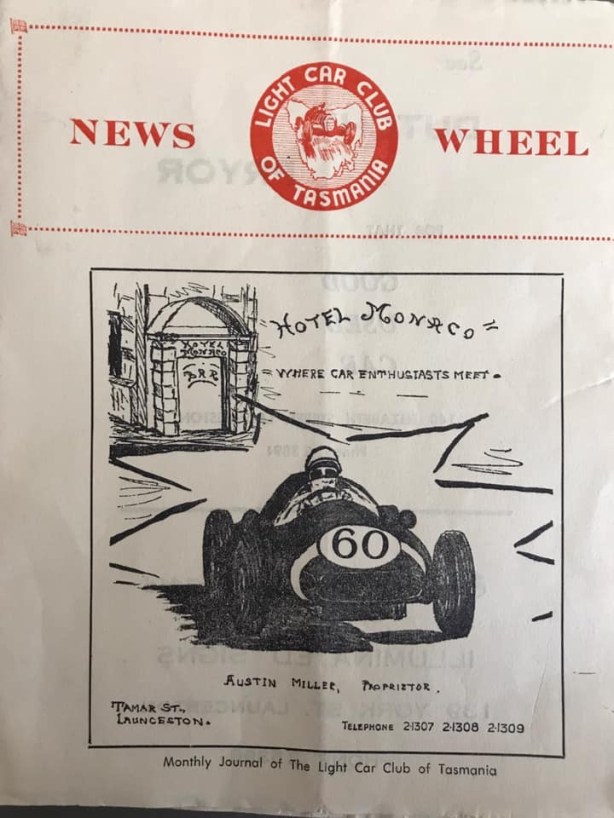
(E French/R Knott)

Cooper T41 Climax, Trevallyn Hillclimb March 1959 Tasmania, Aussie took FTD (Miller)

Miller’s Cooper T41 Climax at Port Wakefield during the October 1959 Gold Star meeting- Greg McEwin in the Mac-Healey alongside (K Drage)
Aussie continued to develop the T41 further by replacing the standard Citroen derived gearbox with a more sturdy Porsche 356 unit and installation of trailing arms (radius rods) to better locate the rear suspension. Austin again won his class of the Victorian Road Racing Championship and the Phillip Island Gold Star round in his new Cooper T51.
Single-seater racing expanded strongly in Australia at the time partially because of improved economic times and in large measure due to the ready availability of Grand Prix Coopers and Coventry Climax engines at ‘reasonable cost’. An international season was developing nicely in Australasia which morphed into the ‘Tasman 2.5 Formula’ and Tasman Cup in 1964- in short, if one had a car you could test your abilities against the best in the world in more or less equal machines and have a crack at the domestic Gold Star Series which itself grew and grew in stature, before dying on the vine a couple of decades hence.
Austin saw the opportunity to progress, he sold the T41 and jumped aboard a Cooper T51 in October 1959. Chassis ‘F2-20-59’ was imported new by Bib Stillwell and raced briefly by Bib and Stan Jones before passing to Miller, his first race in the 2.2 litre FPF engined car was at Island as stated above.
In a ‘Chinese deal’ Jones raced the car once or twice after Aussie owned it, during this period Jones collided with Len Lukey’s Cooper at Phillip Island- as a result the car was fitted with a frame made on the jig Lukey had created for this purpose. It would be very interesting to know just how many T51 jigs there were and still are in Australia! Jones then raced the car to fourth in the 1960 NZ GP at Ardmore before Miller next- finally got his hands on it.

Austin in a Ferrari Monza on the set of ‘On The Beach’ (Miller)
In an eventful 1959 Miller had a brush with Hollywood when he was contracted to perform as a stunt and stand-in driver for Fred Astaire in the movie ‘On The Beach’, filmed in Australia and based on Neville Shute’s novel of the same name, topically it is about the end of the world…
Into 1960 Aussie had some success with the T51 in Gold Star and other competition, perhaps it was his his busiest year of competition.
By that stage there was plenty of depth in Australian single-seater Formula Libre fields with some serious money was being spent by the likes of Stan Jones, Bib Stillwell, Alec Mildren, Lex Davison, Len Lukey and others, so Austin’s efforts in the self prepared, reliable Grand Prix Cooper should be seen with that perspective.
He was unplaced in the season opening March Longford Trophy despite qualifying up the pointy end of the field, the race was won by Jack Brabham from Alec Mildren and Bib Stillwell- all in Cooper T51s, but Austin made a big impression in the Monday Scratch Race for racing and sportscars. AMS reported that ‘One of the finest duels of the meeting occurred in this event when Austin Miller in a 2.2 litre Cooper Climax fought a long battle with Jon Leighton in a 1960cc model. Miller held the advantage and led, but ignominiously lost face and position when he misjudged a corner and was forced to take an escape road.’
Off to Westernport for the next round at Phillip Island in Victoria on 13 March the circus rumbled across the old wooden bridge from San Remo to Newhaven and settled in Cowes for a few days where the ‘Isle Of Wight’ was and still is the centre of social activity.
Brabham had still not returned to Europe and would again win the feature race, The Repco Trophy but Aussie started from the third row and raced in third place for some laps before tyre wear meant he yielded to Bib and finished fourth behind Jack, Bill Patterson and Bib Stillwell, all, again, T51 mounted.
The Victorians took in the Phillip Island Easter Saturday meeting before heading up overnight to Bathurst with Austin second and third in his two races won by Stillwell each time. It would have been interesting to see Stan Jones having a run in the ‘old girl’ Maybach 4 Chev in the last race of the day winning from Ray Gibbs’ Cooper Climax and Stumpy Russell’s Holden Spl whilst the serious Coopers had commenced the tow north towards the NSW border.
Alec Mildren was well into his stride with his Maserati engined Cooper T51, the locally developed car concepted by Alec and built up by Glenn Abbey was the class of the field during the Easter weekend at Mount Panorama on 17/18 April but Austin raced well jumping into an immediate lead of the first heat, finishing second aft of Alec but ahead of Bill Patterson and Queenslander Glynn Scott’s Coopers.
Mildren led from the starters flag of the Bathurst 100 from Stillwell and for 8 laps the pair provided a great dice, the lead of the race changed a number of times but near the end of the eighth tour Bib slid on oil near Murray’s and hit the wooden fence near the Timing Tower.
Bib was ok but the car was out for the day leaving Miller in a strong second place until brake trouble forced him to ease back a bit- Arnold Glass caught and passed Aussie when he went up the escape road at Hell Corner (end of Conrod Straight). ‘Miller had returned to the fray to come sixth’, whilst in front of him were Mildren, Glass, Patterson, Noel Hall and John Roxburgh- all in Coopers with the exception of Arnold Glass aboard the ex-works/Hunt/Stillwell Maserati 250F.
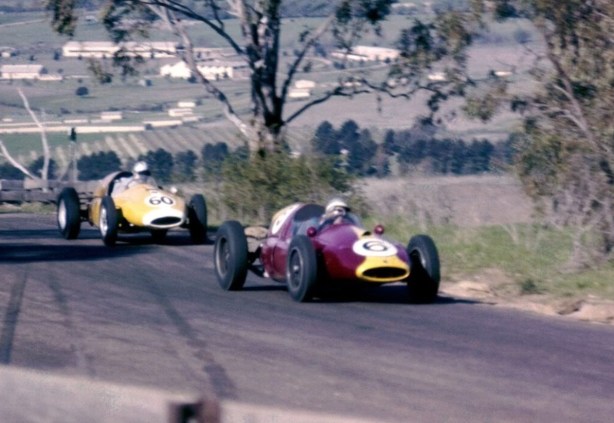
Bib Stillwell and Austin at Reid Park Gates, Bathurst in October 1960 during the ‘Craven A International’ won by Brabham’s similar Cooper T51 Climax (J Ellacott)

Miller, Cooper T51 Climax 2.2, Mount Panorama October 1960. The sign says ‘Superior Cars’- one of Stan Jones dealerships in Melbourne, very naughty of Austin too- such flagrant commerce was crass and not in accord with CAMS rules on advertising on cars at all- I wonder how many meetings it took before they spanked him? (J Ellacott)
What a tonic that second place would have been! Austin didn’t take his car to Lowood, Queensland for the ‘thriller-diller’ June AGP won by the hair on your chinny-chin-chin slimmest of margins by Mildrens’s Cooper from ‘Dame Nellie Melba’ Lex Davison, the comeback kid missed by the smallest of margins winning another Australian Grand Prix aboard a newly prepared 3 litre but old school, front engined Aston Martin DBR4/250.
Crazy were the Victorians who raced at Lowood competing at Phillip Island the following day, the 13 June Queens Birthday meeting- whilst Austin was fresh Stillwell and Patterson were not having contested the AGP the day before but both were there (in their second T51s I guess?)- Austin took a second and third in minor events but in the 10 lap Reg Hunt Motors Trophy race finished a strong second behind Bill Patterson but in front of the Stillwell and John Roxburgh Coopers, and Stan Jones- giving his Maserati 250F a run.
Speaking of Jones, Austin ran his Cooper at the Fishermans Bend Sprints on 5 June to get the final tuning of his T51 sorted for the Island the week later and who should be running on the same day but Alan Jones, ‘Following in fathers footsteps…he made a spectacular entry into open competition by cleaning up his young opponent in true G.P style, his mount- a Whirlwind go-kart powered by a 125cc motor mower engine…his time of 28.3 seconds after a push-start over the line wasn’t all that bad and it accounted for the under 1100cc racing class.’ I wonder if this is the first time AJ made it into a race report and results sheet? Now when did he start hill-climbing the Motor Improvements built Mini I wonder…
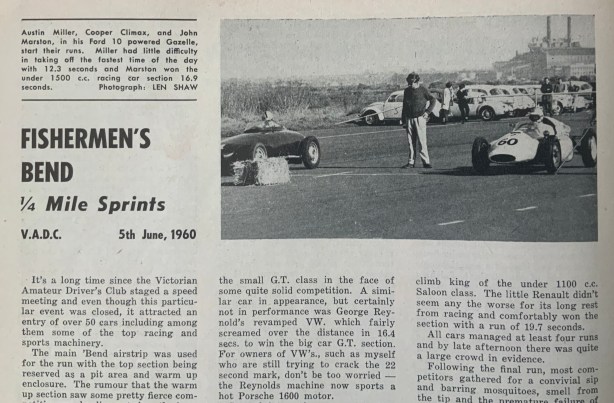
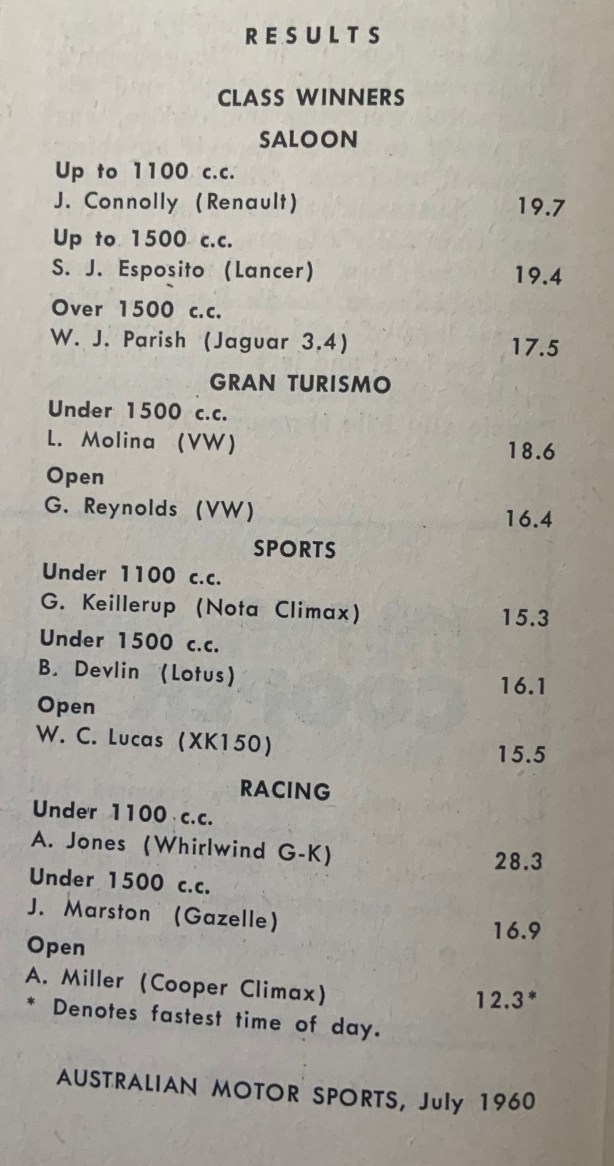
Fishos Sprints results listed for posterity- see A Jones and A Miller

Jack Myers tells Austin where to go- WM/Cooper Holden and T51, Bathurst Easter 1960
Austin didn’t enter the Queensland Road Race Championship, again at Lowood, in September, but returned to the Gold Star fray (make that serious competition fray because this event wasn’t a Gold Star round) in the Craven A International race at the traditional Bathurst October meeting where Jack Brabham prevailed, over the biggest grid of the year, as the 1960 World Champion won from Patterson and Stillwell all in 2.5 litre FPF powered Coopers with Miller a DNF- engine problems.
He failed to start at Mallala in October or at Caversham- Perth is such a long tow! but raced in the Lukey Trophy at Phillip Island in mid-December and finished a strong second, seven seconds adrift of Patterson’s T51- Stillwell was third.
The Warwick Farm Trophy was held the weekend after the Island, and whilst the new, fantastic circuit constructed around one of Sydney’s horse racing tracks was not a Gold Star round it attracted a good entry with Stillwell winning the 10 lap feature from John Youl, Miller, Davison having another run in the Aston Martin but also having lustful thoughts about Coopers however much he didn’t like the ‘Mechanical Mice’, and Doug Whiteford- all but Lex in T51s.
Mildren won the 1960 Gold Star from Stillwell and Patterson.
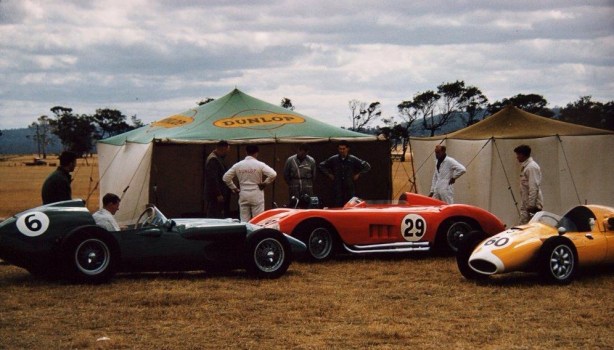
Longford Trophy paddock March 1961, Roy Salvadori won in a Cooper T51 Climax. #6 Bib Stillwell’s Aston DBR4/250 3 litre DNS- raced his Cooper T51, Doug Whiteford’s Maser 300S and Aussies Cooper T51 Climax 2.2 (R Lambert)
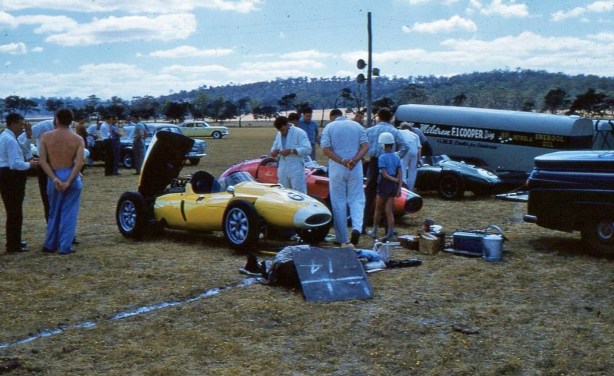
Longford Trophy paddock March 1960, Brabham won in a Cooper T51. Austin topless, Cooper T51 2.2, Arnold Glass Maser 250F and Alec Mildren’s Cooper T51 Maserati (R Lambert)
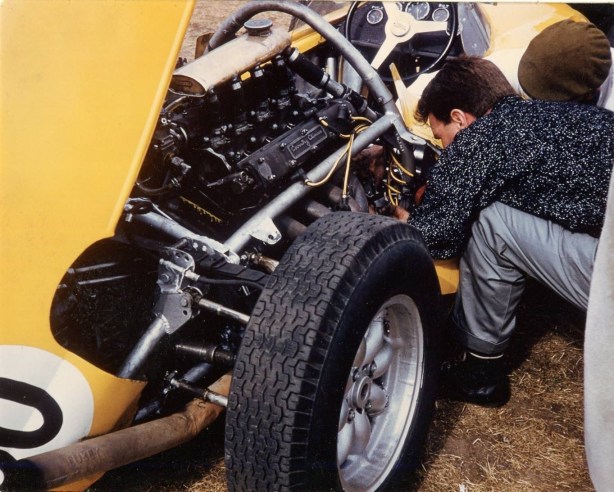
Aussie sets to work on the 2.2 litre Coventry Climax FPF, Longford 1960 (G Richardson)
In early 1961 Austin continued to campaign the Cooper in the summer internationals, opening his account with a strong fourth in the Warwick Farm 100 behind Stirling Moss in Rob Walker’s Lotus 18 Climax, Innes Ireland’s works Lotus 18 Climax and Stillwell’s Cooper T51 Climax. All three cars were fitted with full 2.5 litre FPF’s compared with Aussie’s 2.2, by this stage other locals Jones, Mildren, Glass and Patterson were using 2.5 litre engines whilst Davison’s Aston Martin DBR/4 was fitted with a 3 litre DBR/1 sportscar unit.
That summer internationals contestants included Jack Brabham and Ron Flockhart in Cooper T51s and Graham Hill and Dan Gurney in works BRM P48s- the first time BRM, having raced on and off in New Zealand since 1954, added Australia to their Southern Summer tour.
Austin was eighth in the Victorian Trophy at Ballarat Airfield, won by Gurney’s BRM, fourth in the Longford Trophy won by Roy Salvadori in a Cooper T51 and sixth in the Craven A International at the short, tight, new, Hume Weir circuit close to the New South Wales/Victorian border near Albury in March- Brabham prevailed in the two races that weekend in his T53 Lowline.
At that point Austin’s Cooper became Australia’s first Formula 5000 car…
Miller had become obsessed with a desire to break the Australian Land Speed Record which was then held by one of his fellow Gold Star competitors, Mel McEwin, in Tornado 2 Chev, a car I wrote about a while back. Click hear to read about this amazing front engined Australian special; https://primotipo.com/2015/11/27/the-longford-trophy-1958-the-tornados-ted-gray/
Not having the budget to purchase or build a purpose-built car capable of breaking the record, Aussie and his engineer/mechanic Geoff Smedley set about modifying Miller’s Cooper T51 in the loft of the building next to the Hotel Monaco.

Shots above and below are perhaps press shots in Launceston immediately after the modified T51’s build (G Smedley)
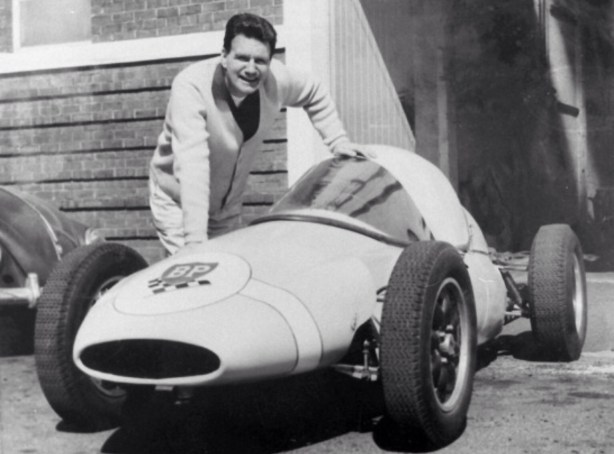
(G Smedley)
Geoff Smedley’s story of this amazing adventure is set below.
‘This is perhaps the most unlikely but successful challenge to a Land Speed Record ever staged and it comes with a story that is equally remarkable.
I had known my friend, the late Austin Miller, for a number of years previously. We had raced cars together in earlier times. Around 1959 when Austin came to live in Tasmania after recovering from a fairly major air crash in Victoria- he had operated an aerial crop spraying business for many years and decided at that time that perhaps a slower pace of life would be better suited to his well-being. So he bought a hotel in Launceston, renovated it and renamed it The Monaco Hotel which soon became the hub for motor racing fans from far and near.
It could be argued that the array of beverages served at the Monaco may have instigated the record attempt! Not so! But it was Aussie’s infectious desire and persuasive talents that eventually won out and the idea grew into reality early in 1960, I was entrusted in putting together a vehicle that could better the current record of 157.5 MPH set by Ted Gray in the ‘Tornado Chev Special’ at Coonabarabran in 1957.
Some of the difficulties soon became clear, firstly there was no money in the kitty. Meaning that all work had to remain ‘in house’. The only equipment available was the 1959 Cooper T51 F2 fitted with a 2.2 Coventry Climax FPF motor that was Austin’s current race car, but certainly not suitable for the job in hand.
A friend of Aussie’s in Melbourne had just set a water speed record using a Corvette V8 engine. This engine was offered on loan as a starting point to our quest. The thought of stuffing 400 bhp of cast iron Chev into a petite Cooper F2 seemed almost as ridiculous as attempting the record itself.
An assessment of the work needed to adapt the chassis to take the big, brutal Corvette engine proved it would need to be a bit of a ‘suck it and see’ effort or do it as she goes with all chassis work to be undertaken before the transplant could take place’.
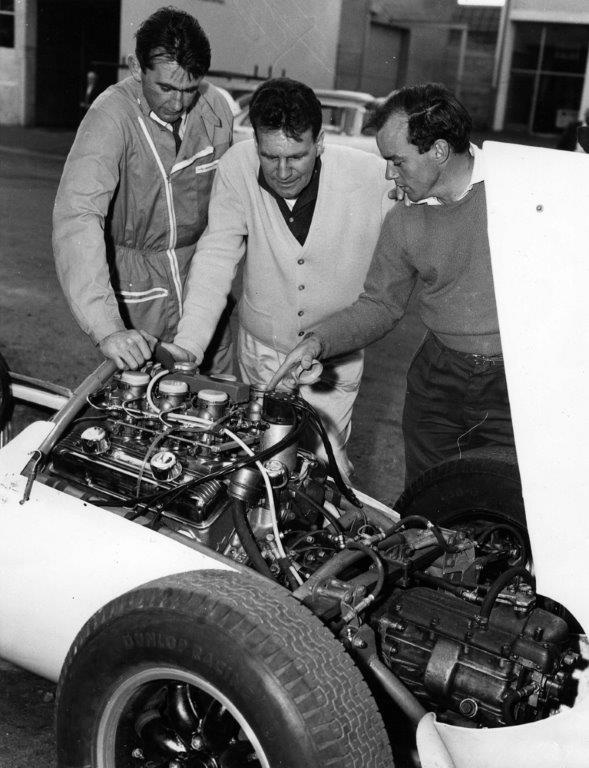
Bruce Burr, Miller and Geoff Smedley- the ‘heavy Chevvy’ looks an easy (cough!) fit (G Smedley)
The engine provided by boat raced Keith Hooper (or Syd Fischer depending upon the source) was highly modified by fitment of some of the best ‘go faster’goodies available for the small-block Chev at the time- Isky cam, ported and polished heads, six twin-choke carbs sitting atop an Offy manifold, lightweight aluminium flywheel and a clutch capable of coping with 400 BHP and equivalent amounts of bulk torque. The fibreglass body of the Cooper was changed marginally in some respects but substantively by the incorporation of a ‘Perspex bubble’ which sat on top of the normal cockpit opening providing better high speed streamlining than the shallow road racing surround.
Geoff picks up the story again.
‘Also the transmission drastically needed modification from the existing Citroen Light 15-based box used by Cooper. To this end I was fortunate in respect of engineering facilities with the family business (Bedford Machine Tools) at my disposal and being a trained engineer I was able to modify this box to a beefy 2 speed specialised unit. With savage cross bolting of the housing, in theory, it would withstand the short lived punishment expected of it. All this together with special beefed up drive-shafts to cope with the extra power were made and, as it seemed, a never ending general tweek in all the right places, eventually we were starting to see some result and the project began to take shape into the car we hoped would bring us success.
The only thing I was fully confident of was the fact that Aussie Miller was one of very few blokes in the world who could steer this mish- mash of bits to success. His long career in flying and driving at the top echelon of open wheeler racing in this country certainly proved he had not only the courage but also the anatomy to do the job’.

(Gray Family)
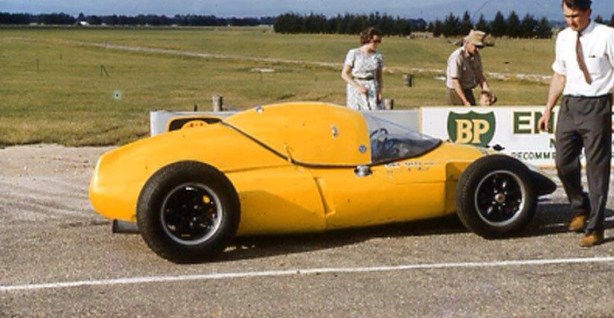
(Gray Family)
Photographs of the car show just how beautifully engineered and integrated the modifications to the standard Cooper T51 were. They were put to the test at Symmons Plains, the circuit built on the Youl family property of the same name 10 miles south of Launceston during October 1961. Austin achieved 140 mph in top gear of his two-speed gearbox before running out of circuit. The car also ran at Trevallyn Hillclimb on 22 October finishing second in the Tasmanian Hillclimb Championship behind John Youl’s Cooper T51 Climax.
‘After the work on the car was finished there was the hassle of setting up the legalities and finding a location suited to such an attempt. We had looked at a few areas as possibilities but each had drawbacks and we needed a course that would give us the very best of chances and a remote beach on the North-West coast of Tasmania at Bakers Beach looked like the ideal place, a little out of sight in case of failure and some 4.5 miles of good surface to set up a good surveyed strip to test our hopes. It took quite a few weeks for our little band of helpers to arrange all the last minute problems including being told that the official timing gear was in Hobart the night before we were about to contest the run which meant someone had to drive the 250 mile journey to retrieve this very important bit of gear.
While this was being attended to my friend Bruce Burr and I decided it would be prudent to take the car to the beach the evening before to eliminate any hold-up on the following day. The best laid plans were in place, we were armed with arrowed placards to be placed on trees showing the way into this well hidden beach, and the evening turned into night before we reached the last mile or so of very dense bush and not having ever tried to visit this remote place in darkness we became hopelessly lost and had diligently placed our signs in areas that have never been found to this day.
Our problems didn’t stop there. Eventually arriving on the Western end of the beach it required about a 4-mile drive in the Land Rover, with car and trailer on tow behind to the Eastern end to a base site we had previously chosen. We were finding this spot hard to locate in the darkness and required driving in the softer sand further up the beach and of course the trailer and race car became bogged and things became hopeless, so we simply unhitched the trailer and moved the Land Rover to a little higher ground and turned in for the night.
We were woken just after daylight by a local TV crew that had somehow found us without the aid of our signs and to our horror we found that the tide was in and was lapping the deck of the trailer and the car looked to be sitting on the water, which presented more of a comedy act than a serious record attempt. Anyhow with the aid of the TV crew we managed to get things into a more respectable state before officialdom and others started arriving, none of whom had seen any of the dozen or so directional signs we had placed the night before.
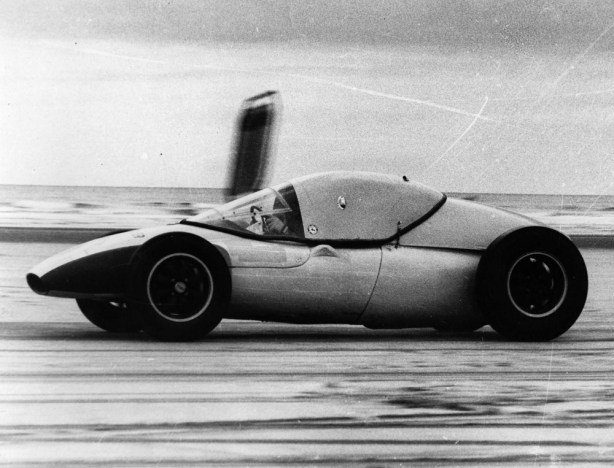
One of the early runs at Bakers Beach with canopy intact Cooper T51 Chev (SLV)
The timing equipment had been brought from Hobart and set up and it was time for the first test runs up the beach. Bearing in mind that this would be the first test of the car itself, it was a very nerve-racking time for me but if Aussie felt the same way he certainly didn’t show it climbing into the car as if heading off on a fun drive up the beach. The first couple of runs looked well but a problem with the timing equipment held proceedings up for some time giving and making all previous runs null and void, but it did give us a chance to delve into a possible gearbox problem which turned out to be a minor adjustment. Stripping a transmission on a beach in the open is not really recommended, soon all was ready for the first official run from East to West.
The car achieved 172 MPH, well on target. We had the car geared for around 202 mph @ 6,500rpm and this first run was looking good. The reverse run was a little down which was expected against a growing wind and adjustments were made to the car before the next speed run. While working on the engine it was necessary to remove the canopy I had made to try and wind-cheat the car. I had rigged up a quick release arrangement for this canopy should the need arise but somehow the mechanism got damaged in the refitting after the previous run causing a major drama on the next attempt.
At an estimated 170 mph the canopy ejected and went skywards also releasing the whole back half of the body and certainly shocked the observers and dimmed the hope of taking the record somewhat, but the ‘never say die Aussie’ the pilot was determined to have a go without such refinements even though beach conditions had deteriorated and the wind was lifting the sand into a heavy haze and pulling down his goggles, the intrepid Miller lad set off, disappearing into a wall of sand and into the record books by pushing the record up to 164.7 MPH, not what we hoped, but a record that would stand for almost 4 years all on the smell of an oily rag.
To reminisce on a time when this sort of thing was possible and practical learning was still in vogue. For me I later entered into F1. As a race engineer where in those early days your skills were required on every aspect of the car, you featured dirty hands but acquired a lot of private satisfaction. It was an era in time we will never see again in the name of motorsport, it was four years later when Donald Campbell in his jet powered Bluebird officially became the fastest man on wheels putting the record up to 403 mph on Australia’s Lake Eyre, but the successful Miller challenge remained for some 4 years and certainly must always remain as a dinkum piston engined record done on a shoestring by a man of his time……… Austin Miller (My Mate!)’ Geoff Smedley.
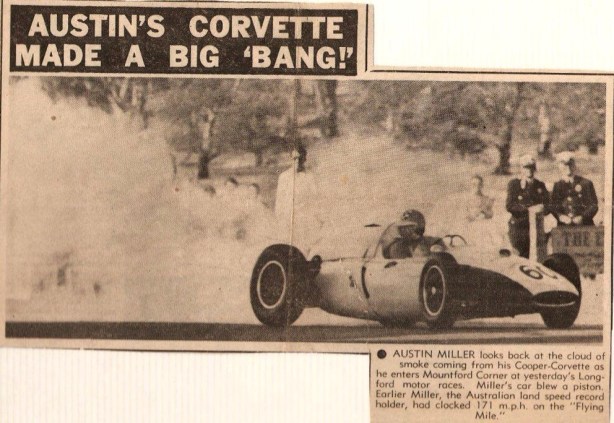
Miller raced the car on into 1962 albeit only briefly.
The Cooper retained its Chev engine and was entered in both the local South Pacific Championship at Longford retiring on lap 2 with valve problems and at Sandown’s opening meeting where the car also failed to finish. Another similar car in concept to Miller’s made a huge impression on Jack Brabham that weekend.
In a one-off Australian entry- it was the only time this car ever raced, Lance Reventlow’s mid-engined Scarab, powered by an aluminium Buick V8- from the same family of engines as that used by Repco in their 1966 F1 World Championship year, the Repco Brabham RBE620 motor was based on a modified production Oldsmobile F85 block. Miller was very much ahead of his time with the thinking behind the V8 engined Cooper.
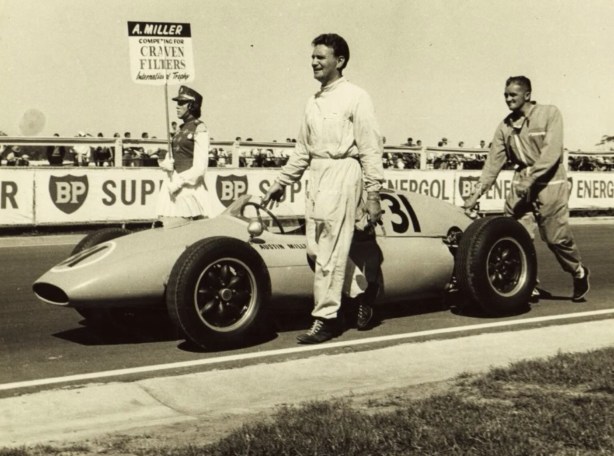
Austin strolls with his T51 Climax the wrong way up Sandown’s Main Straight from the old paddock onto the grid for the start of the feature race at Sandown’s first meeting on 12 March 1962, the ‘Sandown Park International’. Brabham won is his 2.7 litre Cooper T55 Climax- Aussie DNF in the Chev engined T51 (unattributed)
With that, and the local scene becoming ever more professional and expensive, Miller retired from racing to concentrate back on his agricultural spraying business and commercial aviation career.
The Cooper T51 passed through many hands during the sixties and early seventies before John Caffin acquired its remains which comprised the chassis, seat and a fuel tank. The car was fully restored by John, Aussie took great delight in running it a number of times, his T51, like so many of them left Australia many years ago.
Austin, in a very full life was married twice- to Florence with whom he had Vicky and Guy (a handy steerer of historic FFs), and to Judy with whom he had four children- Todd, Ashley, Tracey and Brett. After sale of the hotel in Tasmania he moved back to Victoria to aerial crop spraying- at that stage he bought a de Havilland Beaver and operated out of Derrinallum in Victorias’s Western District, two hours from Melbourne.
Aussie maintained his interest in cars, guesting in demonstrations of his Cooper in the historic era and he applied his mechanical talents to the restoration of the ex-Brabham/Davison Brabham BT4 (‘IC-2-62’) remains but that car was sold to John Coombs in the UK without ever seeing the light of day here.
Miller died aged 85 in 2009 but his name lives on, he is discussed when competitive drivers of that period are being looked at in the manner in which they went about their business and drove- and owner/driver/preparer Miller is much respected for his achievements but I guess racing the Cooper was a soda compared to the daily in-cockpit rigours of an ag-pilot!
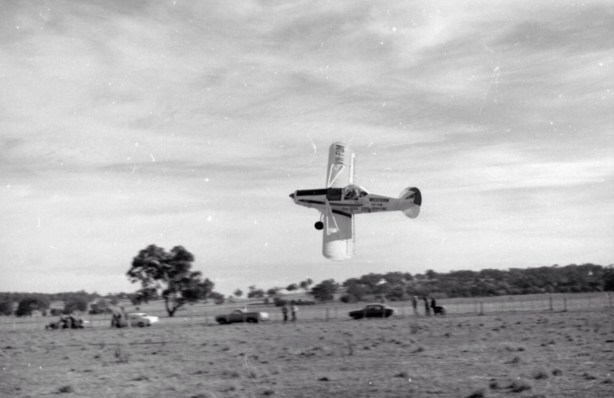
(Miller)
Austin aboard a 235HP Piper Pawnee, Dookie College, between Benalla and Shepparton, Victoria, 1976.
Percival EP.9 Aircraft in Australia…
http://www.goodall.com.au/australian-aviation/percival-ep9/percivalep9.html
Etcetera…

(Miller)
Works touring car driver- Graham Hoinville and Austin drove an Australian Motor Industies Triumph Herald in the 1960 Armstrong 500 at Phillip Island, DNF in the race won by the Roxburgh/Coad Vauxhall Cresta
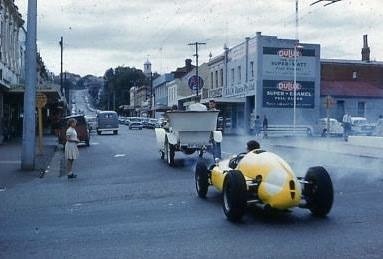
Aussie frightening the Elizabeth Street locals, Launceston circa 1961 (unattributed)
What a road car!
Lady at left seems pretty calm about the vivid yellow Cooper T51 Chev’s presence on the Launceston streetscape. Some type of car show or procession I guess- can someone help with the occasion and date?
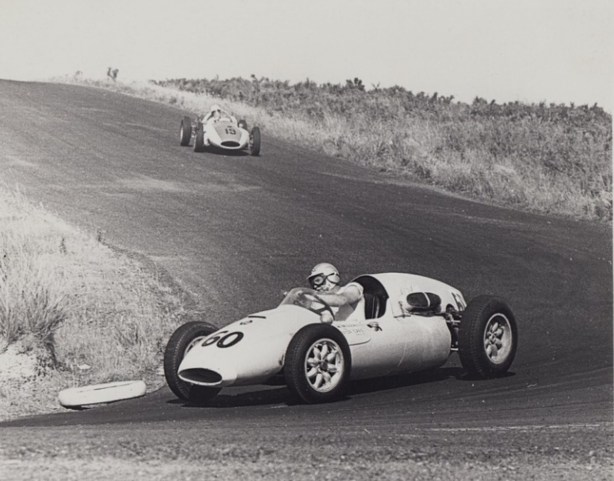
(G Miller)
‘Lukey Trophy’ Gold Star round at Phillip Island in December 1960.
Austin’s T51 with John Roxburgh’s T45 2 litre FPF in the distance on the drop into ‘MG’ corner- Bill Patterson won from Aussie and Bib Stillwell, T51’s all.

(J Ellacott)
Longford Trophy grid, March 1960.
Brabham #4, Stillwell #6 and Miller in yellow- all in Cooper T51s with Glass’ Maserati 250F beside Austin, before the off. Brabham won from Mildren and Stillwell- the dominance of Cooper T51’s in Australia throughout this period comes through in all of this article.
The tables only turned from Cooper when Jack and Ron’s ‘Intercontinental’ Brabham’s- the BT4/BT7A and later BT11A started to come into the country in numbers circa 1962/3 and beyond, but Coopers were dominant in number from 1958/9.
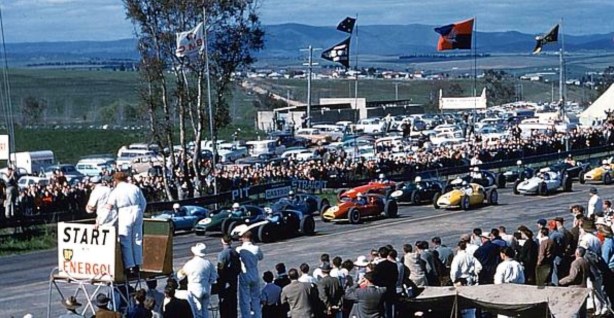
(NMRM)
1960 ‘Craven A’ International grid just before the off, Bathurst October 1960.
I’ve used this shot a couple of times before- it does illustrate the point made a moment ago about Cooper dominance at the time. Stan Jones’ blue T51 is on the outside of row 1, then Alec Mildren’s ‘Mildren green’ Maserati engined variant and then Brabham. John Leighton’s almost invisible T45 and Bib Stillwell’s red T51 on row two. Arnold Glass’ Maserati 250F on row three beside the crowd, then Noel Hall and Austin’s T51s. A row further back its Bill Patterson’s white T51 alongside John Youl’s. The other yellow car at far right rear is Doug Kelley’s ex-Miller Cooper T41 Climax.
Brabham won from Patterson and Stillwell.

(unattributed)
Bathurst I think- Austin, T51 Climax from Alec Mildren, Cooper T45 Climax- then again it may be Alec’s T51 Maserati but it must be 1961 not 1960 as the induction side on the engine in Mildren’s car in 1960 was on the other side, whereas in 1961 it was on ‘this side’ as above. I don’t think Austin’s T51 ever met Alec’s T45 at Bathurst- the T51 Maserati yes. Then again this might not be Bathurst…help, I think.
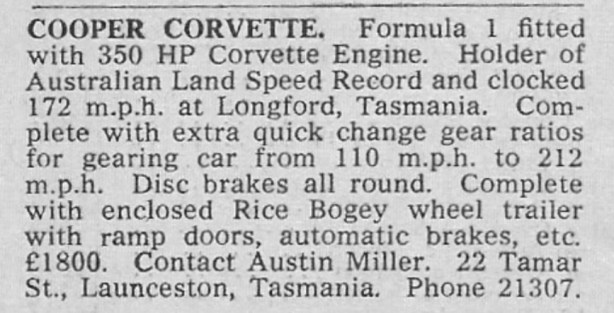

Arcane but sorta relevant…
Austin was a very highly rated pilot, when Commonwealth Aircraft Corporation boss (later Sir) Lawrence Wackett was after a test pilot for his new Wirraway Trainer based CA-28 ‘Ceres’ heavy payload agricultural aircraft in 1958/9 it was to Miller he turned.
Miller and Tadgell, familiar with the Wirraway from their RAAF days, decided to trial the plane as an alternative to their growing fleet of DH.82 Tiger Moths. After obtaining the licence endorsement they needed the Department of Supply sold them two aircraft for 500 pounds each. Both were fitted with a hopper behind the front seat and various designs of spraying equipment, also installed were RAAF underwing extra fuel tanks.
The experiments were successful, so, given Austin’s technical and analytical skills it was to Miller Wackett turned but he was too busy with Super Spread’s operation which by then included Victoria, Queensland, South Australia and Tasmania, not to forget his racing…and family so he let the opportunity pass.
Ultimately 20 of the aircraft were built, CAC transferred the production capacity then released at Fishermans Bend to the RAAF Mirage jet fighter project.
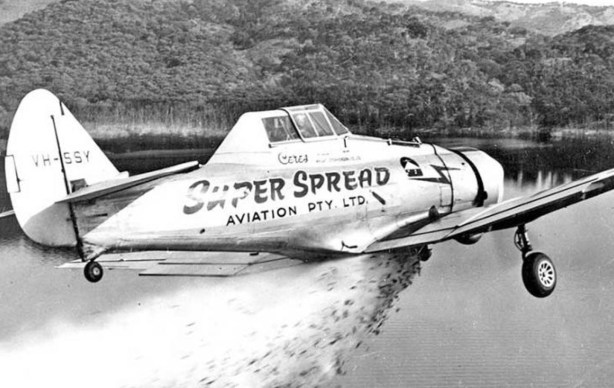
Super Spread CA28-10. Reg VH-CEK and later VH-SSY- Ceres Type C, which was the definitive final production type CA-28 to which most earlier series aircraft were field modified. First registered 20 September 1960. Here in 1962 it’s dropping a load of live fingerling trout into Lake Eildon, in Victoria’s Alpine region between Eildon and Mansfield 150 km from Melbourne- superb shot. This aircraft has, like a racing car, had a few decent hits down the decades, been de-registered and registered again when rebuilt and is still extant (Ben Dannecker Collection)
The most hours on the type were recorded by Super Spread pilot John McKeachie who commented about the plane as follows; ‘The Ceres carried a good load and had an excellent braking system. The Pratt & Whitney R-1340 radial was very reliable and the engine cowls were designed to give easy access for maintenance. It had a 3 second dump with the dump doors not being retractable as the whole bottom dropped out.’
‘The later models were designed to allow the loader driver to be carried behind the pilot. Spare parts were readily available. The aircraft had several negative features, being very heavy on the controls, slow on the turn and very tiring to fly. It was also heavy on fuel, needed a long runway and gave a rough ride when on the ground.’
Bibliography…
Austin Miller profile by Martin Agatyn, article by Geoff Smedley, oldracingcars.com, Aviation Safety Network, Geoff Goodall’s Aviation History Site, various issues of Australian Motor Sports 1958-1960, ‘Glory Days: Albert Park 1953-1958’ Barry Green, oldracingcars.com
Photo and other Credits…
Ron Lambert, John Ellacott, Guy Miller Collection, Greg Richardson, Rob Knott via Ellis French, National Motor Racing Museum, Ben Dannecker Collection, Kevin Drage, State Library of Victoria
Special thanks to Guy Miller and Geoff Smedley
Tailpiece: We have lift-off…

(G Smedley)
Finito…















































































